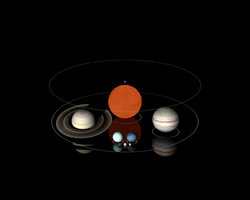| Observation data Epoch J2000.0 Equinox J2000.0 (ICRS) | |
|---|---|
| Constellation | Carina |
| Right ascension | 11h 06m 51.99s[1] |
| Declination | −60° 51′ 45.7″[1] |
| Characteristics | |
| Spectral type | ? (primary)/M (b)[2] |
| Apparent magnitude (I) | 15.61 (system)[1] |
| Variable type | Eclipsing binary |
| Orbit[2] | |
| Period (P) | 7.26867 d |
| Eccentricity (e) | 0.205 ± 0.008 |
| Inclination (i) | 88–90° |
| Periastron epoch (T) | JD 2452342.41 ± 0.02 |
| Argument of periastron (ω) (secondary) | 99.2 ± 0.8° |
| Semi-amplitude (K1) (primary) | 9.642 ± 0.088 km/s |
| Details[2] | |
| OGLE-TR-122A | |
| Mass | 0.98 ± 0.14 M☉ |
| Radius | 1.05+0.20 −0.09 R☉ |
| Surface gravity (log g) | 3.9 ± 0.5 cgs |
| Temperature | 5700 ± 300 K |
| Metallicity [Fe/H] | 0.15 ± 0.36 dex |
| Rotational velocity (v sin i) | 5.7 ± 0.6 km/s |
| OGLE-TR-122B | |
| Mass | 0.092 ± 0.009 M☉ |
| Radius | 0.120+0.024 −0.013 R☉ |
| Other designations | |
V817 Car | |
| Database references | |
| SIMBAD | data |
OGLE-TR-122 is a binary stellar system containing one of the smallest main-sequence stars whose radius has been measured. It was discovered when the Optical Gravitational Lensing Experiment (OGLE) survey observed the smaller star eclipsing the larger primary. The orbital period is approximately 7.3 days. The system's primary is thought to resemble the Sun.[2]
- ^ a b c Udalski, A.; Pietrzynski, G.; Szymanski, M.; Kubiak, M.; Zebrun, K.; Soszynski, I.; Szewczyk, O.; Wyrzykowski, L. (2003). "The Optical Gravitational Lensing Experiment. Additional Planetary and Low-Luminosity Object Transits from the OGLE 2001 and 2002 Observational Campaigns". Acta Astronomica. 53: 133. arXiv:astro-ph/0306444. Bibcode:2003AcA....53..133U.
- ^ a b c d Pont, F.; Melo, C. H. F.; Bouchy, F.; Udry, S.; Queloz, D.; Mayor, M.; Santos, N. C. (April 2005). "A planet-sized transiting star around OGLE-TR-122: Accurate mass and radius near the hydrogen-burning limit". Astronomy & Astrophysics. 433 (2): L21–L24. arXiv:astro-ph/0501611. Bibcode:2005A&A...433L..21P. doi:10.1051/0004-6361:200500025. ISSN 0004-6361. S2CID 14799999.
{{cite journal}}: CS1 maint: date and year (link)
